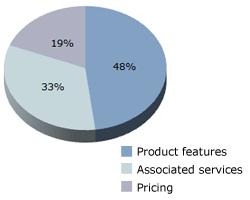
Making pricing decisions requires insights into what customers value in your proposition and an understanding of costs, competitor offers and company strategy.
These are all areas that are fundamental to the product management and product marketing roles.
Why then do so many product managers shy away from active and regular engagement in pricing discussions?
As you can see below the average product manager spends less than 20% of their time on pricing.
Source: Product Focus Product Management Survey 2009/10
Why are Pricing Decisions Often Controversial?
One reason may be that pricing decisions are often contentious – it’s a little like branding and design questions – these are highly visible areas in which everyone has an opinion (though few have the skills & experience to make sound judgments). But, pricing decisions are doubly pressurized because changing a price has a quick, direct and tangible impact, positively or negatively on sales and profitability – and also on sales bonuses and commissions.
Product managers should not allow themselves to become disconnected from front-end pricing decisions. In fact, as a product manager or product marketer, you should embrace pricing issues: it’s a core element of your proposition and who else in the company has the market insight, balanced perspective and long term view needed to be able to set prices?
From your viewpoint, it’s also a great way to engage with customers and the front end to gain more insight. If sales channels are unable to stop discounting find out why and explore options for improvement. Would a focus on the value of your proposition help sustain higher prices? Is it a signal that your marketing is poorly targeted and attracting the wrong customers or an early warning that your proposition is failing to deliver the value envisaged?
Every product manager should understand why customers buy, what they value and what objections they raise. You cannot always resolve pricing objections but you should know what they are, be able to argue for the pricing you’ve established and equip your sales channels to do the same.
You might spend a lot of time deciding on the features of a multi-zillion pound product – do you put enough time into thinking about its price?
Andrew Dickenson
Director, Product Focus


Join the conversation - 3 replies
Love the new blog guys.
Really sensible piece on pricing, though in my experience most companies are rarely sensible in their approach to pricing.
I did a more cynical cut on the topic: http://effectivus.com/2010/03/pricing/
All the best!
Ah, pricing. Always a thorny topic for product managers as it’s one those more subjective areas of the job. I’d love to have some kind of oracular spreadsheet that foresees how much customers would be willing to pay for my new product. Ironically, I would pay good money for such a thing…
Your graph above reinforces my view that (alert: wild generalisation follows) product managers spend the majority of the time looking inside their own organisation rather than focusing on really getting to know their market and its problems.
The thing is that pricing is very tricky to do well without a good understanding of how valuable the problem you’re solving is for the customer. I often use the example of the glass of tap water: in normal day-to-day life, nobody would consider paying for the water; if the same person were dying of thirst in the Sahara, they’d probably value the water a great deal more.
There’s always the danger that product managers price their product purely to cover their costs. ‘Cost to us’ does not equal ‘value to customer’. As always, the answers are out there in the market, not inside your organisation.
In truth the majority of product introductions / development are evolutions of existing products. I read somewhere that less than 10% were what could be described as truly new products rather than evolutions.
Standard practice in PM would be to start your project as your existing product reaches the crest of the PLC. Complete development through the “plateau” stage and introduce before you enter the decline.
As such you have plenty of data on the real arbiter of product pricing – the market. As such your pricing options with the new product are relatively simple, which is same as current product or slightly above – assuming evolution.
Hence the limited time on pricing compared to other areas. Of course pricing becomes more interesting when you are considering different segments of the Ansoff matrix.